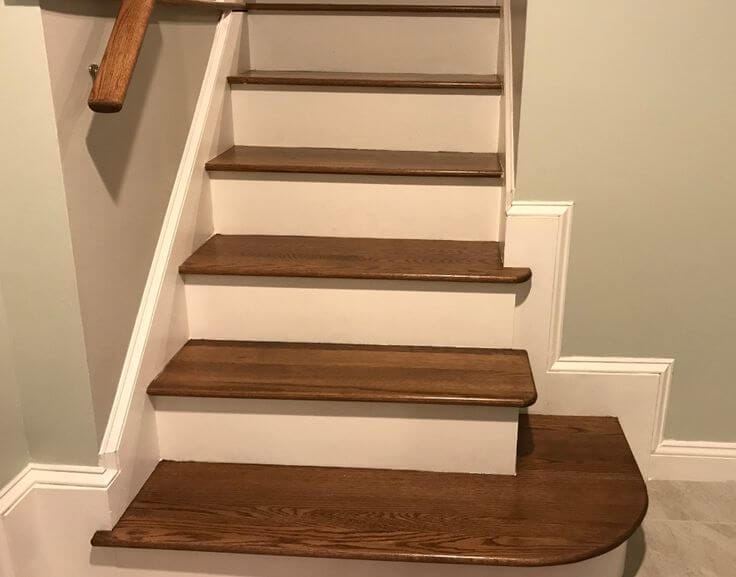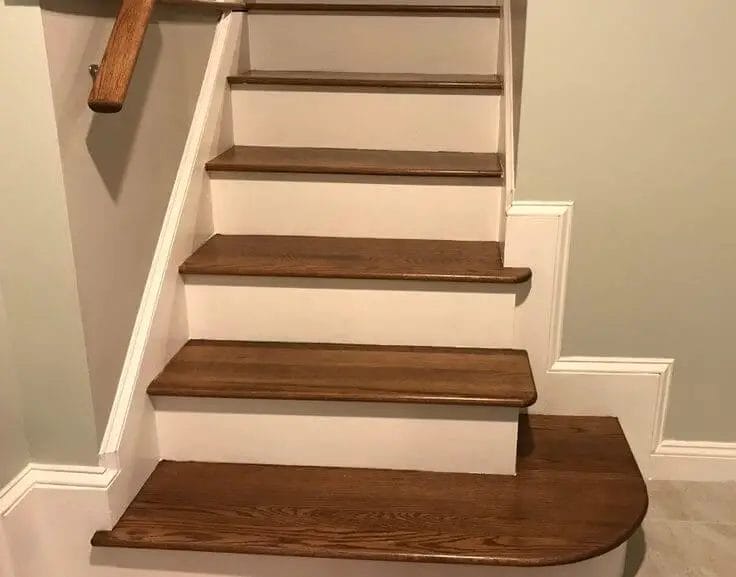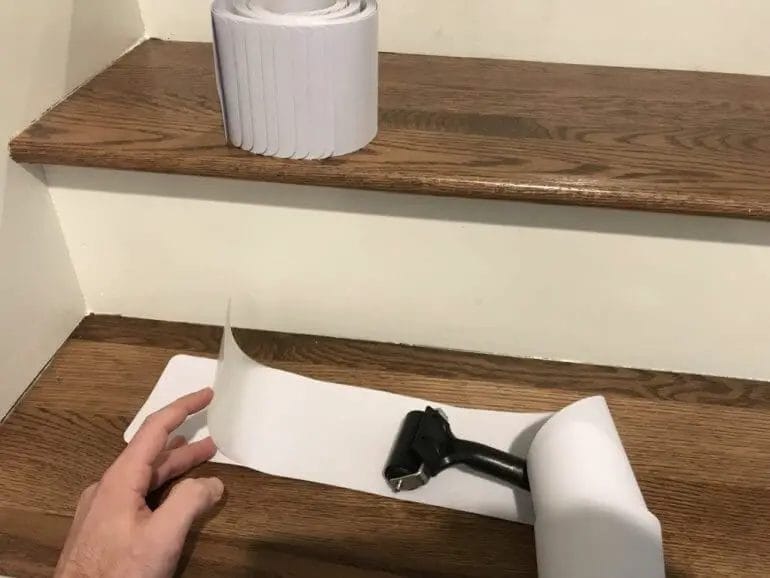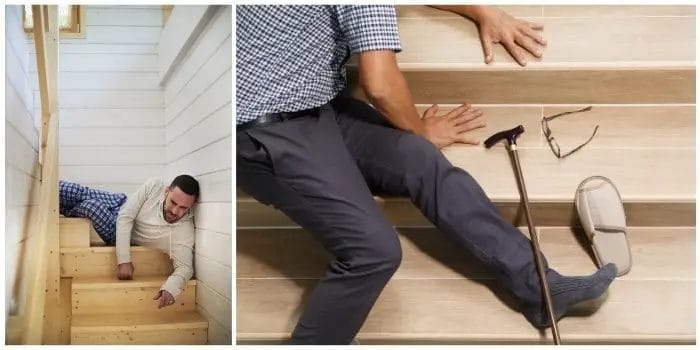Are your wood stairs posing a slip hazard? Don’t worry, we’ve got you covered! Discover effective ways to make your wood stairs less slippery and enhance safety for you and your loved ones.
Slippery wood stairs can be hazardous, especially during wet or icy conditions. To combat this issue, consider applying anti-slip products like adhesive strips or non-slip stair treads. These simple solutions provide extra grip and reduce the risk of accidents.

Another effective method is to add traction by applying a non-slip paint or grip-enhancing coating to your wood stairs. These products not only enhance safety but also add a stylish touch to your staircase.
In addition to anti-slip products, keeping your stairs clean and dry is crucial. Regularly sweep away debris and moisture, as these can contribute to slipperiness. Consider installing handrails for added support and stability as well.
Remember, ensuring the safety of your wood stairs is essential. By implementing these strategies, you can reduce the risk of slips and falls, providing peace of mind for you and your family.

Effective Ways to Reduce Slipperiness on Wood Stairs
Wood stairs are a beautiful addition to any home, but they can also be hazardous if they become slippery. Whether it’s due to moisture, wax buildup, or simply the natural smoothness of the wood, slippery stairs can lead to accidents and injuries. Fortunately, there are several effective methods to reduce slipperiness on wood stairs and create a safer environment for you and your family. In this section, we will explore some of these methods in detail.
1. Add Non-Slip Tread Covers
Non-slip tread covers are an excellent solution for reducing slipperiness on wood stairs. These covers are typically made of rubber or a similar material that provides extra traction. They come in various sizes and designs to fit different types of stairs. The process of installing non-slip tread covers is relatively simple and can be done using adhesive or screws. The textured surface of these covers significantly improves grip and reduces the likelihood of slipping.
2. Apply Non-Slip Tapes
Another effective method to enhance traction on wood stairs is to apply non-slip tapes. These tapes have a rough surface that provides additional grip and prevents slips. Non-slip tapes are available in various widths and colors, allowing you to choose the option that best matches your staircase’s aesthetics. To apply non-slip tapes, thoroughly clean the stairs, cut the tape to the desired length, and stick it onto the stair treads. Make sure to press firmly to ensure a secure bond.
3. Use Anti-Slip Stair Mats
Anti-slip stair mats are specially designed to reduce slipperiness on wood stairs. These mats are made of durable materials that offer excellent traction and can withstand heavy foot traffic. They are typically available in different sizes to fit various stair dimensions. Anti-slip stair mats come with adhesive backing or can be installed using double-sided carpet tape. Their textured surface provides a firm grip and helps to prevent slips, making them a popular choice for enhancing stair safety.
4. Apply a Non-Slip Finish
Applying a non-slip finish to wood stairs is an effective way to increase traction and reduce slipperiness. There are specific non-slip finishes available in the market that are designed specifically for wood surfaces. These finishes contain additives that create a textured surface, improving grip and minimizing the risk of slipping. Before applying the non-slip finish, ensure that the stairs are clean and free of any dust or debris. Follow the manufacturer’s instructions for proper application and drying times.
5. Regularly Clean and Maintain Your Stairs
Regular cleaning and maintenance can go a long way in preventing slipperiness on wood stairs. Keep your stairs free of dust, dirt, and debris, as these can make the surface more slippery. Avoid using wax or polish on the stairs, as they can create a slick surface. Instead, use a mild detergent or wood cleaner to remove any buildup and maintain the natural texture of the wood. Additionally, ensure that any moisture or spills are promptly cleaned to prevent slippery conditions.
6. Improve Lighting and Handrail Installation
Proper lighting and the installation of handrails can significantly enhance safety on wood stairs. Insufficient lighting can make it difficult to see the stairs clearly, increasing the risk of slipping. Ensure that the staircase is well-lit, especially during nighttime. Installing handrails provides an additional support system, giving you something to hold onto if you lose your balance. Make sure the handrails are securely attached to the walls and are at a comfortable height for all users.
In summary, slipperiness on wood stairs can be a safety concern, but there are effective methods to reduce the risk of accidents. Adding non-slip tread covers, applying non-slip tapes, using anti-slip stair mats, applying a non-slip finish, regularly cleaning and maintaining the stairs, and improving lighting and handrail installation are all practical ways to make wood stairs safer. By implementing these measures, you can enjoy the aesthetic beauty of wood stairs while prioritizing the safety of your household.

The Best Non-Slip Solutions for Wooden Stairs
Wooden stairs can add a touch of elegance and warmth to any home. However, they can also be slippery, especially when wet. This can pose a serious safety hazard, particularly for young children, seniors, and individuals with mobility issues. Fortunately, there are several non-slip solutions available that can help make your wooden stairs safer and reduce the risk of accidents. In this section, we will explore some of the best non-slip solutions for wooden stairs.
1. Anti-Slip Tape
One of the most popular and cost-effective non-slip solutions for wooden stairs is anti-slip tape. This adhesive-backed tape features a textured surface that provides excellent traction, even when the stairs are wet. Anti-slip tape is easy to apply and can be cut to fit the size of your stairs. Simply clean the surface of the stairs, peel off the backing, and press the tape firmly in place. It is important to choose a high-quality tape that is designed for outdoor use and can withstand heavy foot traffic.
2. Non-Slip Stair Treads
If you prefer a more permanent solution, non-slip stair treads are a great option. These treads are made from durable materials such as rubber, vinyl, or fiberglass, and are designed to fit over the existing steps. Non-slip stair treads come in various sizes and designs, allowing you to choose the one that best matches your staircase. They can be installed using adhesive or screws, providing a secure and long-lasting non-slip surface.
3. Non-Slip Paint
Another effective non-slip solution for wooden stairs is non-slip paint. This specially formulated paint contains additives that create a rough texture, providing excellent grip and traction. Non-slip paint is available in a variety of colors, allowing you to maintain the aesthetic appeal of your wooden stairs while enhancing safety. It is important to properly prepare the surface by cleaning and sanding the stairs before applying the paint for optimal adhesion and durability.
4. Carpet Runners
If you prefer a more traditional look, carpet runners can be a practical and stylish choice for non-slip protection on wooden stairs. These long, narrow rugs are designed to cover the middle portion of the stairs, leaving the edges exposed. Carpet runners can be secured in place using carpet tape or adhesive stair rods. They not only provide traction but also add warmth and comfort to your staircase.
5. Rubber Stair Mats
Rubber stair mats are another excellent non-slip solution for wooden stairs. These mats are made from durable rubber material and feature a textured surface that effectively prevents slips and falls. Rubber stair mats can be easily installed by placing them directly on the wooden steps. They are available in various sizes and designs, allowing you to choose the one that best suits your staircase.
6. Clear Non-Slip Coatings
If you want to maintain the natural beauty of your wooden stairs, clear non-slip coatings can be an ideal choice. These coatings are transparent and provide a non-slip surface without altering the appearance of the wood. Clear non-slip coatings are typically applied with a roller or brush and can be used on both indoor and outdoor wooden stairs. It is important to choose a high-quality coating that offers long-lasting protection against slips and falls.
In summary, there are several non-slip solutions available for wooden stairs that can enhance safety without compromising the aesthetic appeal of your staircase. Whether you choose anti-slip tape, non-slip stair treads, non-slip paint, carpet runners, rubber stair mats, or clear non-slip coatings, it is important to carefully consider your specific needs and preferences. By taking proactive measures to make your wooden stairs safer, you can provide peace of mind for yourself and your loved ones.

DIY Methods to Make Your Wood Stairs Less Slippery
Having wooden stairs in your home adds a touch of elegance and warmth. However, one common problem with wood stairs is that they can become slippery, especially when they are wet. This can be a safety concern, especially if you have children or elderly individuals in your household. Fortunately, there are several DIY methods you can try to make your wood stairs less slippery.
1. Apply Anti-Slip Treads
One of the easiest ways to make your wood stairs less slippery is by applying anti-slip treads. These treads are specially designed to provide traction and grip on slippery surfaces. They are typically made of durable materials like rubber or adhesive strips that have a textured surface to prevent slipping. You can easily find anti-slip treads in hardware stores or online. Simply measure the dimensions of your stairs, cut the treads to size, and adhere them to the surface of each step.
2. Use Non-Slip Carpet Runners
Another option to consider is using non-slip carpet runners on your wood stairs. These runners not only add a decorative touch to your staircase but also provide a non-slip surface. Look for carpet runners with a rubberized backing or anti-slip pads to ensure they stay in place. Measure the length of your stairs and choose a carpet runner that fits the dimensions. Secure it to the stairs using carpet tape or rug grippers to prevent any sliding.
3. Apply Non-Slip Paint or Varnish
If you prefer a more permanent solution, you can consider applying non-slip paint or varnish to your wood stairs. These products contain additives that create a textured surface, enhancing grip and reducing the risk of slipping. Before applying the paint or varnish, make sure to clean and sand the surface of your stairs to ensure proper adhesion. Apply the product according to the manufacturer’s instructions, and allow it to dry completely before using the stairs.
4. Install Stair Nosing
Stair nosing is a type of tread that is specifically designed for the front edge of each step. It provides an extra layer of traction and can significantly reduce the risk of slipping. Stair nosing is available in various materials, including rubber, metal, and wood. Choose a material that complements the look of your staircase and install it using adhesive or screws for added stability.
5. Regularly Clean Your Stairs
Keeping your wood stairs clean and free from dirt, dust, and debris can also help prevent slips and falls. Sweep or vacuum your stairs regularly to remove any loose particles that could make the surface slippery. Additionally, mop your stairs with a mild soap and water solution to remove any stickiness or residue. Avoid using excessive amounts of water, as this can damage the wood.
In summary, there are several simple and cost-effective DIY methods you can try to make your wood stairs less slippery. Whether you choose to apply anti-slip treads, use non-slip carpet runners, apply non-slip paint or varnish, install stair nosing, or simply keep your stairs clean, these solutions can greatly improve the safety of your wood stairs and provide peace of mind for you and your family.
Step-by-Step Guide to Prevent Slips on Wood Stairs
Wood stairs can be a beautiful addition to any home, but they can also be a potential hazard if they are slippery. Slips and falls on stairs can result in serious injuries, so it is important to take the necessary precautions to prevent accidents. In this guide, we will walk you through step-by-step on how to make your wood stairs safer and slip-resistant.
1. Clean the Stairs
The first step in preventing slips on wood stairs is to ensure they are clean. Dust, dirt, and debris can accumulate on the surface of the stairs, making them slippery. Use a broom or vacuum cleaner to remove any loose particles from the stairs. Additionally, consider using a damp cloth or mop to wipe down the stairs for a thorough cleaning.
2. Apply an Anti-Slip Coating
Applying an anti-slip coating to your wood stairs is an effective way to increase traction and prevent slips. There are various types of anti-slip coatings available on the market, such as non-slip paints, adhesives, or tapes. Choose a coating that is specifically designed for wood surfaces and follow the manufacturer’s instructions for application.
3. Install Carpet or Stair Treads
If you prefer a softer and more comfortable feel underfoot, consider installing carpet or stair treads on your wood stairs. These can provide additional traction and reduce the risk of slips. Choose a carpet or stair treads that are specifically designed for stairs and ensure they are securely attached to avoid any tripping hazards.
4. Add Handrails
Having handrails on your wood stairs can provide support and stability, especially for those with limited mobility or balance issues. Install handrails on both sides of the stairs, ensuring they are securely attached to the wall. Make sure the handrails are easy to grip and at a comfortable height for users.
5. Improve Lighting
Poor lighting can contribute to slips and falls on stairs. Ensure that your wood stairs are well-lit to enhance visibility and reduce the risk of accidents. Install bright, energy-efficient light fixtures at the top and bottom of the stairs, as well as along the stairway if needed. Regularly check and replace any burnt-out bulbs to maintain adequate lighting.
6. Practice Good Housekeeping
Maintaining good housekeeping habits can go a long way in preventing slips on wood stairs. Encourage everyone in your household to keep the stairs clear of clutter, toys, shoes, and other objects that can create tripping hazards. Regularly inspect the stairs for any loose boards or nails and repair them promptly to ensure a safe walking surface.
7. Educate Household Members
Lastly, educate all members of your household on the importance of stair safety. Teach them to use the handrails while going up or down the stairs and to be cautious and aware of their surroundings. Encourage them to take their time and avoid rushing on the stairs, as this can increase the risk of slips and falls.
By following this step-by-step guide, you can significantly reduce the risk of slips and falls on your wood stairs. Taking the necessary precautions and implementing safety measures will create a safer environment for everyone in your home.
FAQs
How can I make wood stairs less slippery?
To make wood stairs less slippery, you can apply non-slip adhesive strips or anti-slip stair treads to the surface of each step. You can also use non-slip varnish or paint to create a textured surface. Additionally, keeping the stairs clean from dust and debris can help reduce slipperiness.
How can I improve traction on wood stairs?
To improve traction on wood stairs, you can install carpet runners or stair mats. These can provide a grippy surface and reduce the chances of slipping. Another option is to apply a non-slip coating or adhesive tread tape to the stairs. Regular cleaning and maintenance of the stairs can also help maintain traction.
Are there any natural remedies to make wood stairs less slippery?
Yes, you can use natural remedies to make wood stairs less slippery. One option is to mix equal parts vinegar and water to create a cleaning solution. Use this solution to clean the stairs and remove any slippery residue. You can also sprinkle baking soda or cornstarch on the steps to create friction and reduce slipperiness.
Conclusion
In conclusion, making wood stairs less slippery is an essential step to improve safety and prevent accidents. By implementing the right strategies, you can reduce the risk of slips and falls and create a more secure staircase. Applying anti-slip solutions such as adhesive strips, non-slip paint, or clear treads can significantly enhance traction on the stairs. Additionally, investing in high-quality floor mats or rugs at the bottom and top of the stairs can provide additional grip and absorb any moisture. Regular maintenance, including cleaning the stairs and promptly addressing any damage or wear, is vital to sustaining a safe and slip-resistant staircase.
Remember, prioritizing safety is crucial when it comes to wood stairs. By incorporating these precautions, you can transform your slippery stairs into a secure and reliable path for everyone to navigate confidently.